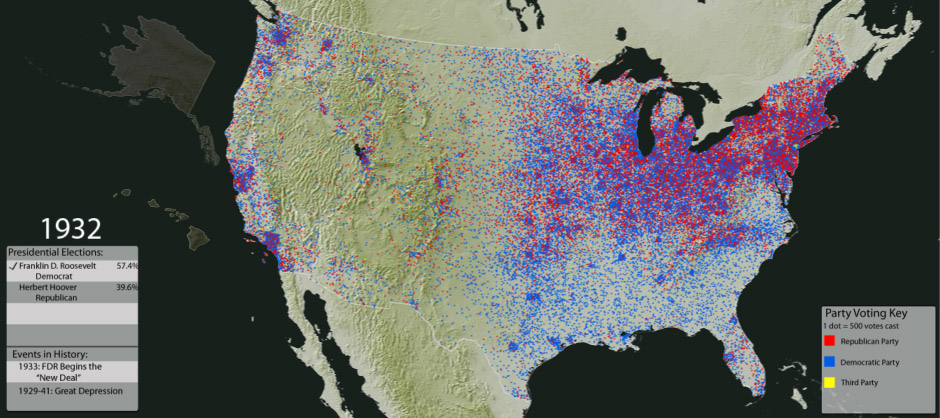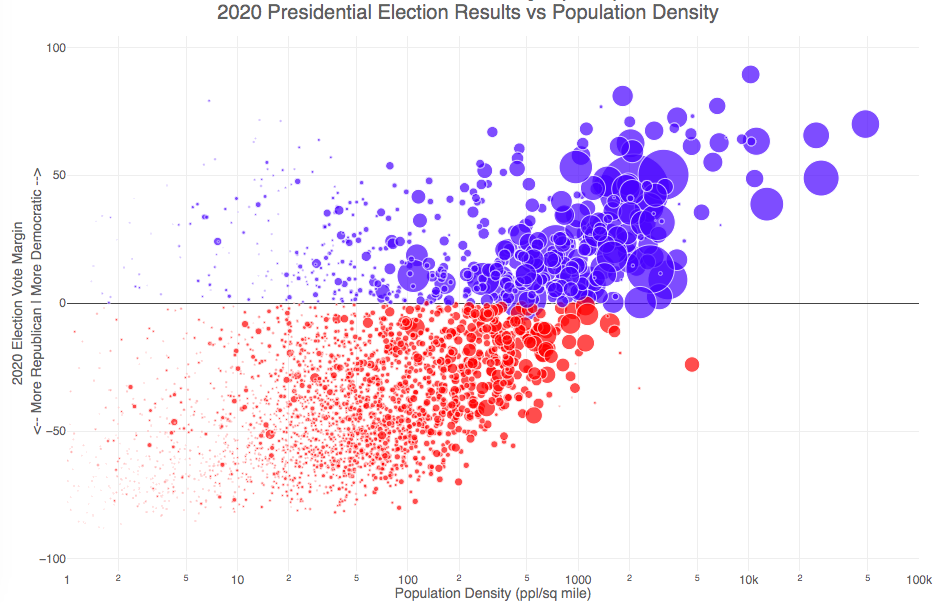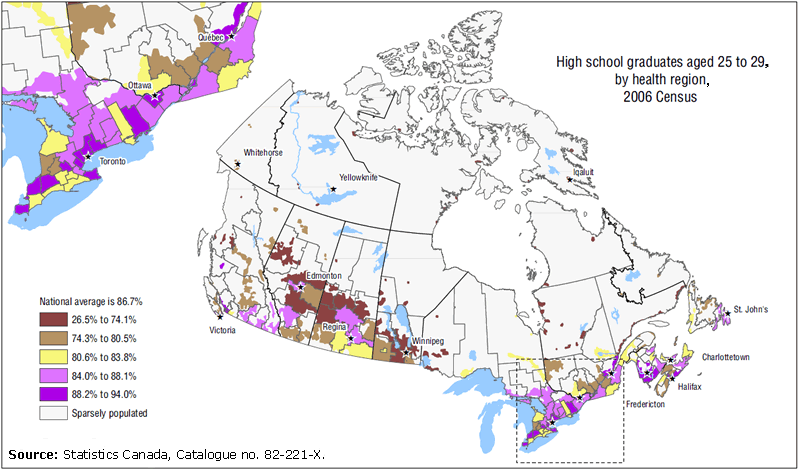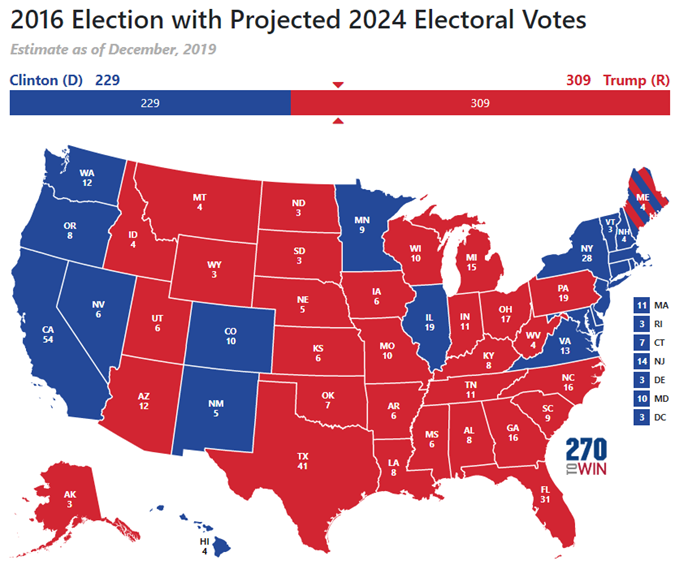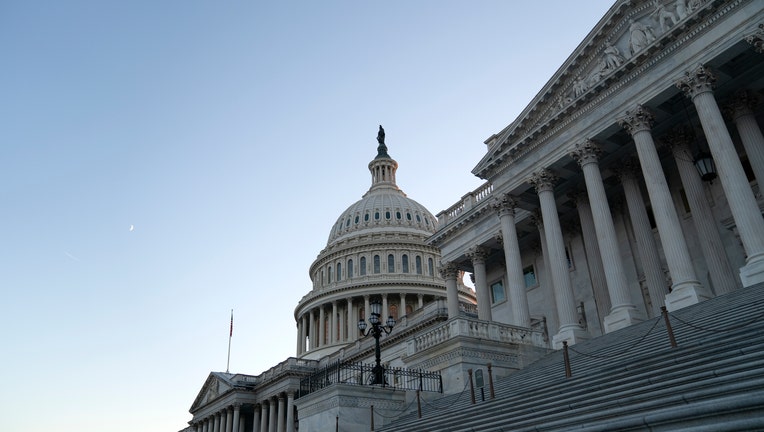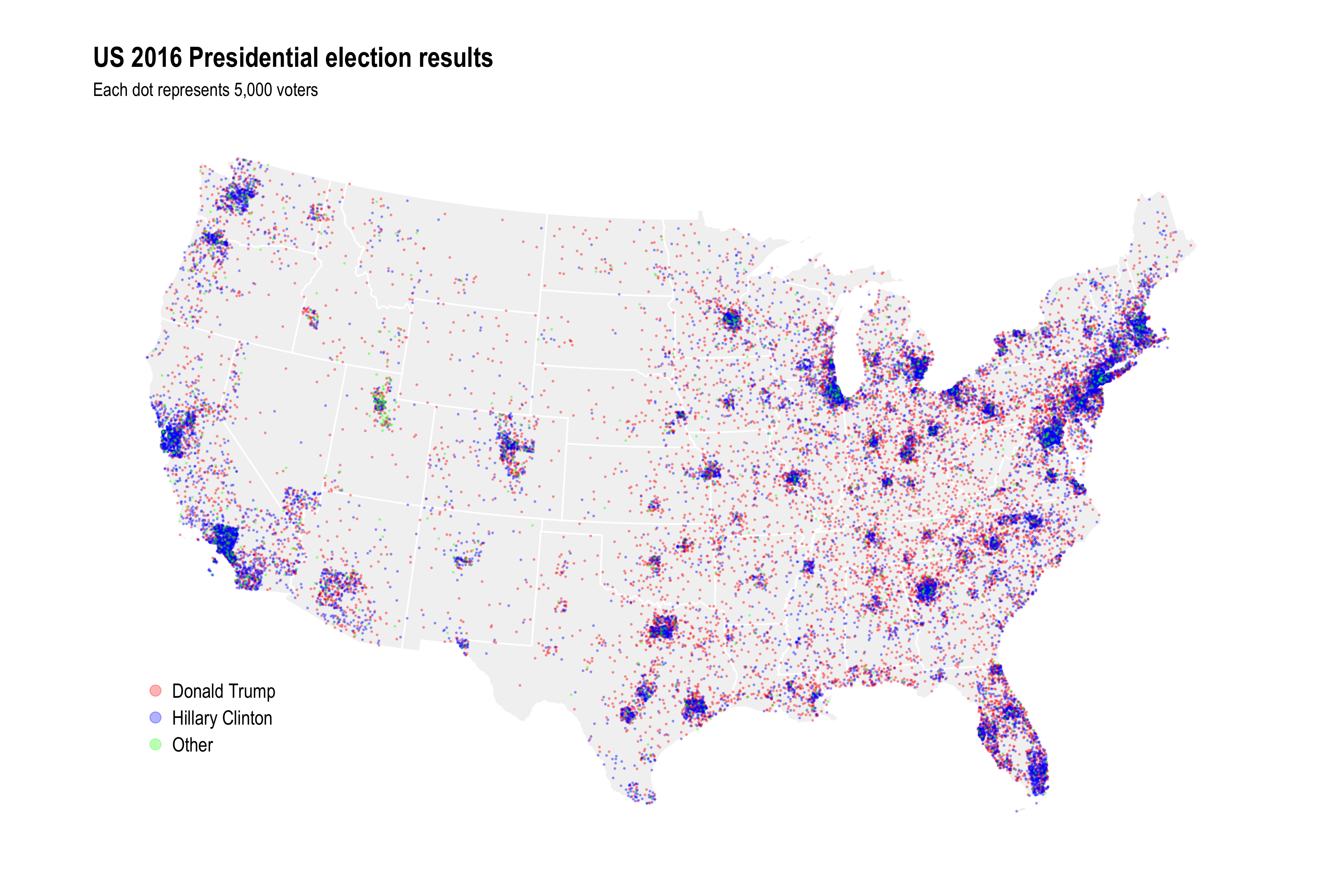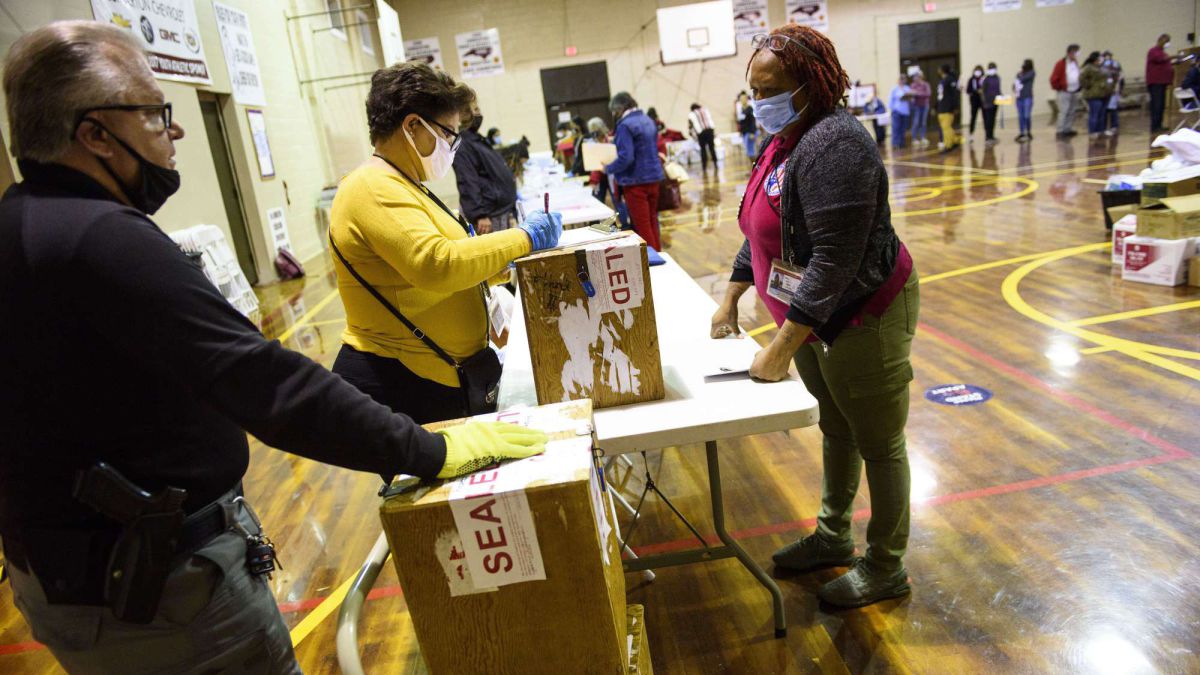The dashboard supports spatio-temporal visualization of various factors such as COVID-19 cases, social distancing metrics , rally distribution, poll results, and voting results across the country. Please note that all the visualization examples in Figs.4 and5 come from the dashboard, while we rearrange the layout to avoid incomplete display (e.g., Alaska) or overlapping (e.g., toggleable legends). We can observe how these factors vary geographically across the country and how they change over time.
Such spatio-temporal visualization helps users better track and understand the dynamics of the pandemic, social distancing performance, and political support. The county-level presidential election results and the rally data can also be visualized in the dashboard. Note that we didn't show the voting results in Alaska because, according to our data source, the voting results in Alaska are collected at the election-district level while our voting result map is at the county level. Figure5 exhibits the spatial heterogeneity of the relative electoral support for each candidate and reveals the states, counties, and cities that presidential candidates focused on during the campaign. Here we use an old map of French metropolitan regions in 22 different political entities. In alternative specifications, we used a finer set of 95 dummies for départements, which correspond to more decentralized political entities in France .
First of all, turnout rates are strongly and negatively affected by population density , which is in line with our expectations. In 2020 , a 10% increase in population density decreases turnout rates by 1.24% (respectively 0.76%). Interestingly, the impact of this variable is significantly larger in 2020, compared to 2014. This illustrates that the perceived risk of becoming infected when voting was higher in municipalities with more people per square kilometer around polling stations. The problem with choropleth, or shaded area maps like these is that while technically accurate, they do not show the full picture of population, and therefore votes. In this map, visual weight is based on the size of each state, rather than on the number of votes.
This means that large, sparsely populated states like Montana with its 3 electoral votes appear to be more prominent on the map than geographically smaller, but more densely populated states such as Massachusetts, which casts 11 electoral votes. So if we wanted to know who won the 2016 presidential election, this map isn't very helpful. However, it does reveal geographic voting patterns that can help us see clusters of Democratic-leaning states in New England and on the West Coast.
There are some things we could do to improve this map, like adding text about the number of electoral college votes each state casts, but that still requires significant effort on the part of the map reader to parse. A bar chart would be more appropriate for showing the number of electoral votes cast for each candidate. Four years ago, I put together a short post about the challenges of mapping election results in US Presedential elections.
The core of the issue is the sharp difference between population density and land area. Yet votes in the US aren't entirely disconnected from area due to our country's state-by-state voting system. The popular vote matters in each state, but the ultimate winner is decided by votes of official electors put forward by each state to participate in the electoral college.
The end result of this system is that winning a state by 5 million votes doesn't earn a candidate any more than winning by 1 vote. This means that the final election result can distort the perception of popular support for a candidate. I proposed a map design four years ago that tried to communicate a balanced view of both state-by-state and popular vote margins. This map looks at the 2020 and 2016 presidential election results, county by county. An interesting thing to note is that this view is even more heavily dominated by the color red, for the same reasons.
Less densely populated counties tend to vote republican, while higher density, typically smaller counties tend to vote for democrats. As a result, the blue counties tend to be the smaller ones so blue is visually less represented than it should be based on vote totals. More than 75% of the land area is red, when looking at the map based on land areas, while shifting to the population view only about 46% of the map is red. Neither of these percentages is exactly correct because each county is colored fully red or blue and don't take into account that some counties are won by a large percentage and some are essentially tied.
However, the population number is certainly closer to reality as Trump won about 48.8% of the votes that went to either Trump or Clinton. Geographic polarisation also hurts Democrats' chances in the electoral college, America's system of choosing its president. In this year's election, for example, Mr Biden will win the national popular vote by about five percentage points. But his margin in the "tipping-point" state that ultimately gave him enough votes to win the election, Wisconsin, will be less than one point. That four-point advantage for the Republicans is the biggest in at least four decades.
So long as Democrats continue to be the party of the cities, and Republicans the party of small-town and rural America, those biases will persist. Democrats nearly doubled the party's margin in metro area Atlanta—the third-largest Democratic gain among the 27 million-plus population metro areas in the 13 swing states. In total, the party improved its performance by 5.5 percentage points, making Biden the first Democratic presidential candidate to win Georgia since Bill Clinton in 1992.
Biden's support in Atlanta was even more potent due to the increase in the metro area's vote share relative to 2016. Georgia is on track to add an electoral vote this year, driven almost entirely by population growth in the booming Atlanta metropolitan area. Taken together, Field says, these methods offer a far more detailed illustration of voter turnout than, say, the map in Yingst's tweet. That map uses different shades of red and blue to indicate whether candidates won by a wide or slim margin.
But by completely coloring in all the counties, it gives counties where only a few hundred votes were cast the same visual weight as counties where hundreds of thousands of votes were cast. But on the dasymetric dot density map, it's the blue that stands out, conveying the difference between the popular vote, which Clinton won, and the electoral college vote, which Trump won. The Popular Vote Density Map attempts to convey a more nuanced view of the recent presidential contest than the ubiquitous red/blue state map.
So, the sparsely populated Great Plains and Rocky Mountain West are shown in a much lighter color than the Eastern Seaboard, and the map as a whole is more purple than either red or blue. Perhaps the United States is less divided than some maps would lead us to believe. In other words, according to the winner-take-all policy, a candidate may earn 49.9% of a state's popular vote and earn 0% of the state's electoral votes. Inswing states, opinion polling shows there is no candidate with a large lead. While the electoral votes from states that consistently vote for the Democrat or Republican candidate count just as much as electoral votes from any other state, candidates typically can't win the presidency without also winning at least one swing state. That dynamic results in the majority of campaign efforts being focused in these states where the results could go either way.
Viewed through the lens of swing states, winning the overall election is possible only through victories in closely-polling states. In this work, we design and implement a narrative-based geovisualization dashboard for the 2020 US presidential election. The dashboard takes campaign rallies and major events from September 1 to November 3, 2020, as narrative clues to illustrate the process of the presidential election.
Multiple-perspective factors including COVID-19 infection cases, social distancing metrics, and poll results are collected, processed, and integrated into the dashboard for spatio-temporal visualization. We also design a series of interactive functions such as rally tracking and location synchronization to support the interactive narrative for the presidential campaign. The user evaluation result shows that the data and functions in our dashboard are sufficient, the user experience is smooth, and the interface design is suitable. For the temporal aspect of social distancing metrics, both the percent change in mobility and the median home dwell time have regular fluctuations on a weekly basis, and the overall trends are stable. One possible reason is that after going through the early outbreak of the COVID-19 and pandemic control policies such as the stay-at-home orders and mask mandates, people start to adapt to the pandemic and gradually return to their daily lives.
However, the spread of the COVID-19 still continues, and the cumulative COVID-19 cases rise from around 6 million on September 1, 2020, to over 9 million on November 3, 2020. Spatially, geographic deviations exist in the distribution of COVID-19 cases and social distancing metrics. Overall, people living on the East Coast and the West Coast have lower travel mobility and higher median home dwell time compared to residents in the Midwest and the Mountain West. Also, the number of COVID-19 cases per 1000 people has a notable growth rate in the Midwest and the South. One reason could be that the states on the East Coast and the West Coast have more effective pandemic control policies, and people better practice social distancing (Grossman et al. 2020).
This may also be reflected in the polling data and electoral results, which show that residents on the East Coast and West Coast are more likely to support Biden, who is associated with stricter policies to address the pandemic. Since all state have two Senators, smaller states are over-represented in the Electoral College. This interactive map shows the number of electoral votes each state would have if only census population was considered and applies it to the 2016 presidential election. Interestingly, despite Clinton winning the popular vote, the electoral map totals would have been little different. Located in the northern Midwest, Wisconsin is part of the Great Lakes region. Wisconsin's 2019 population is estimated to be 5,832,661 with a growth rate of 0.33%.
It has 65,497.82 square miles of surface space; it is the 23rd largest state in the country and the 20th most populous in the US. The census of 2010 showed a community of 5,686,986, and the population for 2019 is 5.83 million. This figure reveals that Wisconsin had a growth rate of 1.5% in the last census in the US in 2010 and the 2019 census.
There is an average of 105 people for every square mile of Wisconsin's extensive surface area. With a population of more than 600,000, Milwaukee is Wisconsin's largest city. Madison, with a community of 248,000, Green Bay with a populace of 105,207 and Kenosha with a population of 99,858, are the next largest cities.
Milwaukee's Metropolitan area is estimated to have a population of 1.55 million. Milwaukee and Dane counties have 952,085 and 536,416 people, respectively, which make them Wisconsin's largest counties. The 36th largest state in the country is Tennessee, which sits in the southeastern part of the US. It covers 42,143 square miles, with an average of 153.9 people per square mile. Tennessee's 2019 population is estimated to be 6,833,793, an increase from the 2010 Census which reported 6.34 million. It was confirmed at the nationwide census in 2010, that Tennessee had a population of 6,346,105, showing an increase of 11.5% from the 2000 census.
The 2016 estimated population of 6, 600, 2996, suggest that Tennessee's population is still growing; the current growth rate is 0.86%. Located in the southeastern corner of the North American continent, Georgia is the 21st largest state in total size . Its population density is above average at around 185 people per square mile, with the average being around 87. Its most populated county is Fulton County with over one million residents, making it almost twice the population of Wyoming. The state of Georgia is divided into 159 counties in total; that amount is almost more than any other state except for Texas, which has 254 counties. Georgia's least populated county is Taliferro County, with only 1608 people living in the entire 195 square miles.
This narrative-based geovisualization dashboard supports various applications such as spatio-temporal visualization and interactive narrative for the presidential election. Also, the presidential election data displayed in the dashboard and the interactive narrative function together help users track the presidential campaign and partisanship across space and over time. But an analysis of the election results by The Economist suggests that the partisan divide between America's cities and open spaces is greater than ever. Preliminary results supplied by Decision Desk HQ, a data-provider, show that voters in the least urbanised counties voted for Mr Trump by a margin of 33 points, up from 32 points in 2016. More broadly, the greater the population density, the bigger the swing to the Democratic candidate . Even after controlling for other relevant demographic factors, such as the proportion of whites without college degrees or Hispanics in each county, the data suggest that urban and rural voters are more divided today than they were in 2016.
As detailed in Figure 1, Biden's improvements in Austin and Dallas-Fort Worth were the largest metro area swings for Democrats in 2020. Moreover, Biden's surge in Texas's million-plus population metro areas carried even more punch given that the total vote shares increased in each. But even though Democrats cut Republicans' margin from 16 percentage points to less than 6 over the course of the last two presidential elections, Biden fell short of winning the state, which we speculated was possible, but unlikely. Heavily Latino- or Hispanic-populated counties along the Mexican border—long a Democratic stronghold—saw Biden's margins decline sharply compared with Clinton in 2016. Had the border county margins held steady, Biden would have lost Texas by perhaps less than 4 percentage points.
If Texas eventually moves to the Democratic column, then the GOP's path to 270 electoral votes narrows significantly, particularly given that Texas is poised to gain multiple electoral votes after the 2020 census-based reapportionment. While the population's growth rate is slow in Ohio, it still is higher than most of the country. Ohio's population density of 287 people per square mile far exceeds the national average of 87, ranking it 10th in the nation, with a total land area of 44,825 square miles. The state of Indiana covers 36,418 square miles, making it the 38th largest state by land area; however, its population makes it the 16th most densely populated state in the country, with a population density of 181 people per square mile. The largest city in Indiana is its capital, Indianapolis, with over 863,700 residents, making it more populated than North Dakota on its own.
Indiana's smallest city is Liberty, with a population of only 2,061 residents as of 2019. Based on the 2010 census, Arkansas has grown 3.57% in population from 2.9 million people to 3,013,825 in 2018 and 3,026,412 people in 2019. The population density is below average at 58 people per square mile, making Arkansas the 34th most populated state in the country. Little Rock serves as the state's capital and is the state's largest city in terms of population, with almost 200,000 residents.
As introduced in Section "Data", we collect the COVID-19 infection cases, social distancing metrics, poll results, rallies and events, and presidential election results from multiple data sources and providers . Then, we match the data to the US county map or state map based on their aggregation granularity using the spatial join operator. For the rally and event data, we keep them as data tables and the GPS locations of rallies are recorded in the table for further geovisualization.
Statistical indicators such as COVID-19 cases per 1000 people are calculated during this process. Lastly, all the data are formulated as Esri Shapefiles or Comma Separated Values files and are uploaded to ArcGIS Online, a cloud-based GIS mapping platform by Esri. The whole data preparation process can be iterated regularly to keep the data correct and up to date. The tracker tracks the campaign stops made by Donald Trump, Joe Biden, and their running mates from September 1 to November 3, 2020. To Field, there's no such thing as a totally comprehensive map, but he says, "Some are more truthful than others." The so-called dasymetric dot density map is one of them. The term "dasymetric" refers to a map that accounts for population density in a given area.
Instead of filling an entire state or county with the color red or blue to indicate which party won, Field uses red and blue dots to represent every vote that was cast. Then, rather than distributing the dots evenly around a county, he distributes them proportionally according to where people actually live, based on the US government's National Land Cover Database. That's to avoid placing lots of dots in, say, the middle of a forest, and to account for dense population in cities.
It's important to note that even if electoral votes were allocated exactly according to each state's share of the US population or share of eligible voters, the electoral process would not resemble a national popular vote. So, when voters cast ballots for president and vice president on Election Day, they're actually voting for a slate of electors who have pledged to vote for their favored candidates. Most states use a "winner-take-all" system of choosing electors, meaning that — assuming electors vote according to their pledges — all of the state's electoral votes are cast for the candidate that wins the majority of the state's popular vote.
As each state receives electoral votes equal to its congressional delegation (House + Senate), the map will change for the 2024 presidential election. This series of maps is based on the most recent projections for the 2020 reapportionment. It looks at how each of the past five presidential elections would have turned out if the projected 2024 map was in use. Oklahoma has nearly 600 incorporated areas, but only four cities have a population that exceeds 100,000 residents.

